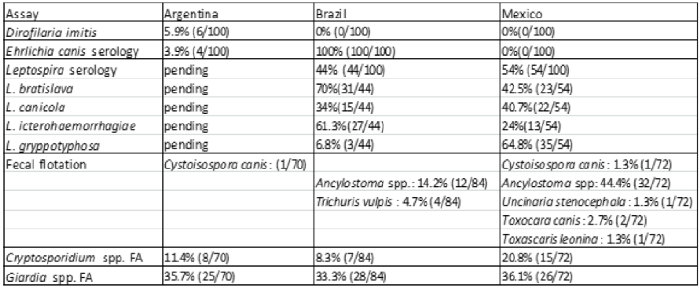Introduction
Dogs can harbor a wide variety of pathogens that could also be transmitted to humans. While prevalence information is available for some of the pathogens in the selected countries, additional information using the most up-to-date diagnostic techniques is needed to unveil accurate information for these and other infectious agents.
Objectives
The objective of this study was to estimate the prevalence of enteric parasites, D. immitis antigen, E. canis antibodies, and Leptospira spp. antibodies in dogs housed in shelters in Buenos Aires, Argentina; São Paulo, Brazil; and Mexico City, Mexico.
Methods
Feces and blood were collected from 100 shelter dogs in each country. Fecal samples were assessed by fecal flotation (FF) by sugar centrifugation and direct immunofluorescence assay (FA) for detection of Giardia spp. and Cryptosporidium spp. Sera were evaluated for antibodies against E. canis by indirect fluorescent assay (IFA) at 1:20; by modified agglutination test (MAT) for Leptospira serovars Bratislava, Canicola, Grippotyphosa, Icterohaemorrhagiae at 1:100; and by a commercially available ELISA for detection of Dirofilaria immitis antigen (WITNESS Heartworm, Zoetis).
Results
The most common infectious agents varied by the country and by shelter management practices. For example, the shelter in Buenos Aires had a rigorous deworming protocol in place.

Conclusions
Prevalence rates are very high for some of the pathogens tested. The Leptospira spp.-positive results likely represent true exposure, as vaccines are not commonly administered to these dogs. These results will support recommendations to lessen the spread of these infections by use of ectoparasite control products, internal parasite control, and appropriate vaccination.